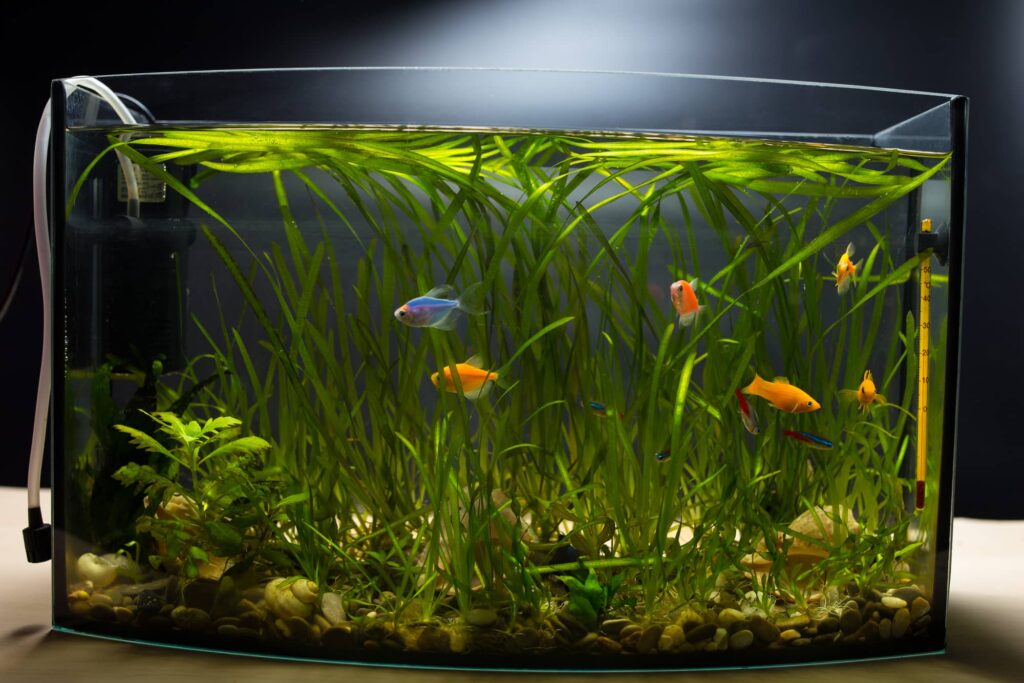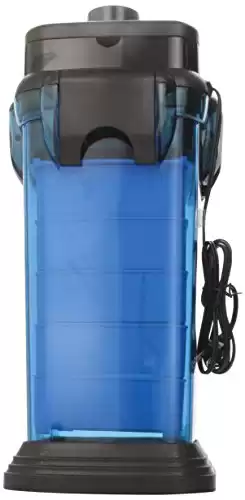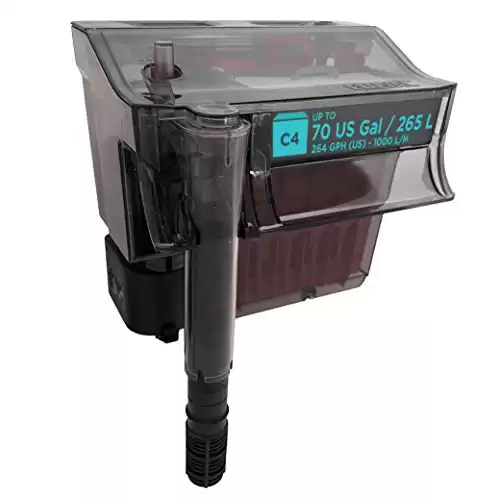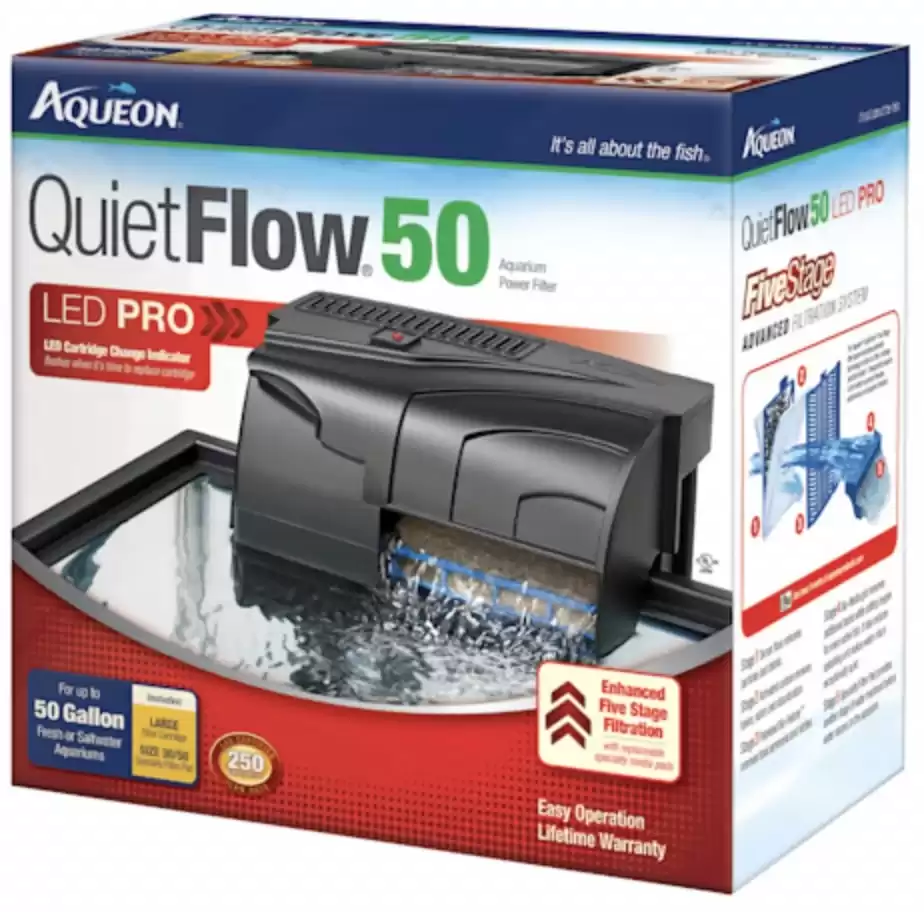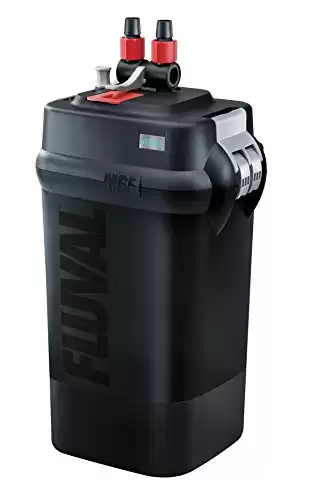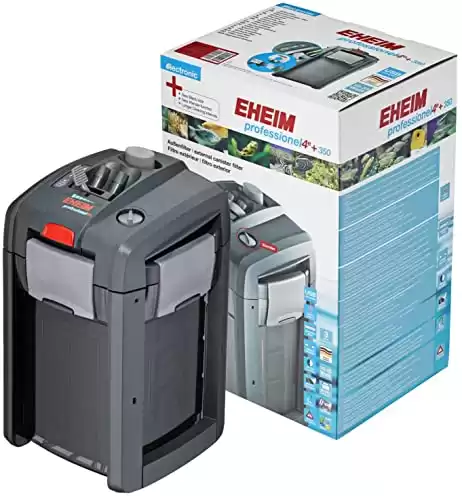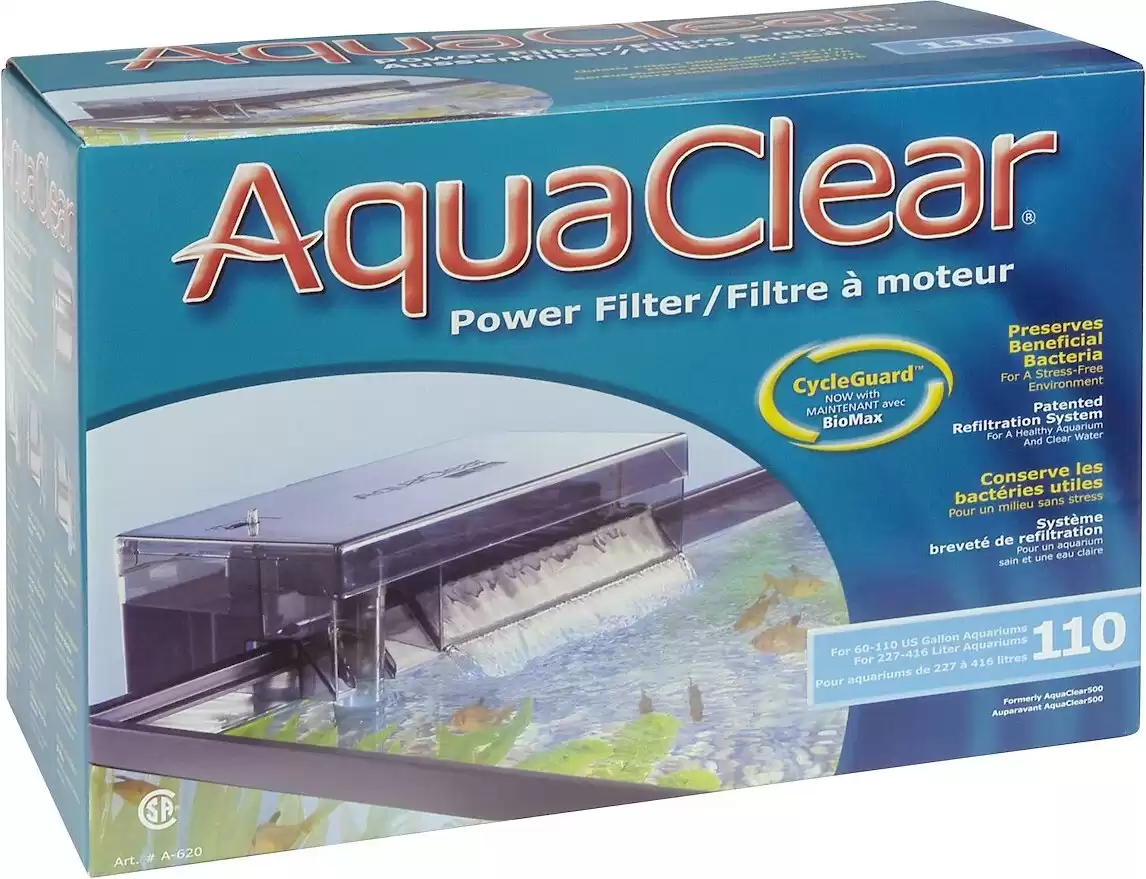Every freshwater and saltwater aquarium needs an effective filtration system that offers mechanical and biological functionality to keep the tank water clean, healthy, and well-oxygenated.
But there are so many filters on the market that choosing the right one is certainly a challenge.
Read this article to learn how to choose the best filter for a 55-gallon aquarium, including reviews of our six favorite filter systems for 55-gallon tanks.
|
Primary Rating:
4.4
|
Primary Rating:
4.3
|
Primary Rating:
3.7
|
Best Filtration Systems For 55-Gallon Tanks
In this first section of our guide, we provide you with product reviews for six of our favorite types of filters suitable for use in 55-gallon aquariums.
Aqueon QuietFlow LED PRO 50 Aquarium Power Filter
- Auto self-priming start pump eliminates messy spills-even if the power goes out
- For fresh or saltwater aquariums
- Includes one free filter cartridge and one free specialty media insert
- LED cartridge change indicator that is specific to your unique aquarium needs
The Aqueon QuietFlow LED PRO 50 Aquarium Power Filter is a simple filter good for smaller fish tanks.
This filter makes maintenance easy by including an LED indicator light that lets the hobbyist know when it’s time to change the media. Otherwise, the overall design is very straightforward and conventional for hang on the back filters.
Hobbyists find that although this QuietFlow filter is supposed to be quiet, it can become noisy over time due to the impeller malfunctioning. It is also prone to breaking faster than other Aqueon products. Luckily, the manufacturer offers a lifetime warranty.
What we like:
- Simple design that’s easy to use
- Keeps water clean when operating
- LED indicator light
Room for improvement:
- Prone to malfunctioning
- Noisy
Fluval 406 External Filter
- Multi stage filtration for healthy fresh & saltwater aquariums
- Suitable for aquariums up to 100 gallons. Flow Rate: 1450 LPH (383 US GPH)
- Sound dampening impeller design for a quieter operation.
Fluval is a very well-established manufacturer that makes high-quality, reliable products.
This Fluval 406 external filter is extremely easy to set up, and the self-priming pump gets the water flowing through the filter quickly and efficiently. This filter unit is quieter than many of the product’s immediate competitors due to the patented noise reduction technology incorporated into the design.
Maintaining the unit is extremely easy, largely thanks to the easy-lift clamps and removable filter baskets.
The drawbacks to this filter unit are that not much hose length or filter media is included with the product.
What we like:
- Versatile filtration
- Extremely quiet running
- Self-priming pump
Room for improvement:
- Could be supplied with more filter media and hose
Eheim Pro 4
Eheim is a highly reputable manufacturer of excellent quality products for the fish-keeping hobby. Eheim filters are simple to set up, easy to clean, and very reliable. I love these powerful, well-designed, efficient filters for larger tanks!
This filter is an external canister-style filter with a push pump button to kick off the siphon process. The adjustable flow rate is ideal if you keep livestock that doesn’t like too much current in their habitat.
The filter media trays are cleverly designed so that you simply lift each one out individually for cleaning purposes. Each tray has a handy triangular marker in the corner to ensure that you align them properly when you replace them in the unit.
The unit features a push-button release that disconnects the outlet and intake valve block, making cleaning quick and simple.
What we like:
- Efficient filtration
- Extremely quiet operation
- Self-priming
- Affordable price
Room for improvement:
- Flow rate can be somewhat variable
- Carbon cartridges not included
Fluval C4 Power HOB Filter
- 5-stage clip-on power filter designed for freshwater and saltwater aquariums between 40 and 70 gallons
- Two mechanical stages trap large and fine debris, foams easily slide out for quick cleaning
- Chemical stage with activated carbon effectively removes toxins
This excellent power filter from Fluval is designed for use with 40 to 70 gallons tank size.
The system is a clip-on, HOB design that features five-stage filtration, including carbon filters, for super-clean water and a healthy environment for your fish. This filtration system is suitable for use with saltwater and freshwater tanks.
The versatile filtration unit features two mechanical stages that trap fine and large floating debris, and the foam media slides out easily for quick, hassle-free cleaning. The chemical stage filter contains activated carbon to remove harmful toxins from the water.
The biological filtration stage features a special Bio-Screen pad that catches debris and provides a huge surface area for excellent bacterial growth. The special Biological Trickle Chamber is packed with patented Fluval C-Nodes for excellent, efficient nitrification.
What we like:
- Optimal filtration
- Customizable filter media
- Self-priming
Room for improvement:
- Sponge filter pad media requires frequent replacement
- Bulky design
AquaClear CycleGuard Power Filter
- Preserves beneficial bacteria for a stress-free environment
- Patented refiltration system for a healthy aquarium and clear water
- Gentle waterfall design creates oxygenation
The AquaClear CycleGuard Power Filter is a HOB unit that moves up to 400 gallons of water per hour, making this filtration system perfect for a heavily planted tank that contains lots of hardscaping.
The filter keeps your fish healthy by using multi-stage filtration, and the GPH flow rate keeps dead spots at bay in a large 55-gallon tank. The system ensures excellent filtration for aquarium water by using mechanical, biological, and chemical filtration. You get a complete set of throwaway filter media cartridges with the system to get you started.
The filter uses a gentle waterfall design that moves cleaned water back into the aquarium without unduly disturbing the water surface, making it the ideal choice for a 55-gallon fish tank containing creatures that don’t appreciate a strong flow rate.
What we like:
- Easy filter setup
- Filter media cartridges included
- 3-stage filtration
Room for improvement:
- Replacement filtration medium is expensive
Penn Plax Cascade 1500 Elite Aquarium Filter
- CASCADE 1500 CANISTER FILTER: Without effort, the Cascade 1500 Canister Filter quietly delivers crystal clear water throughout the tank.
- FILTER MEDIA: This Canister Filter comes standard with 5 Poly Fiber Floss Pads, 1 Coarse Bio-Sponge, and 1 Bag of Activated Carbon.
The Penn-Plax canister filter is an excellent choice if you want extra filtration for your tank.
The unit offers powerful filtration and comes with everything you need for complete filtration for a large tank. You start the filtration process via a push-button primer, and the unit features an adjustable flow knob to change the flow of water into the tank to suit your livestock.
The filter unit has large filter baskets, output/input tubing, and plenty of filter media to start you off. The filter media can be customized to suit your requirements, and the extra-large filter trays ensure that you can use more filter media and replace it less frequently.
What we like:
- Excellent quality filters
- Fully customizable
- Adjustable flow feature
Room for improvement:
- Expensive when compared to other similar products
How Much Filtration Is Needed for 55-Gallon Tanks?
The general guideline for optimal filtration rates is that the total volume of water in your aquarium is circulated around the tank and through your filter system at least once every hour. So, if you have a 55-gallon tank, you need a filtration system that provides a flow rate of at least 220 Gallons Per Hour (GPH).
However, if you keep very dirty fish, such as goldfish, we advise you to choose a filter that offers a slightly higher GPH than you need.
Flow Rate
When choosing a filter for your 55-gallon tank, be aware of the power of the flow rate the unit generates. If you have fish or plants that dislike a strong current, you’ll need to choose a system that features an adjustable outflow valve. Alternatively, you can buffer the flow with tank decorations or bushy plants.
GPH Vs. Turnover Rate
The GPH for filter systems is usually shown on the product packaging. However, sometimes, you’ll see the turnover rate indicated, too.
The turnover rate is not the same thing as the GPH. Essentially, the turnover rate relates to the efficiency of the pump and the filter unit rather than the volume of water the system circulates around your aquarium.
Why Is Choosing The Correct GPH So Important?
If the GPH of your filtration system is not sufficient for your fish tank size, “dead spots” will form. Dead spots are water pockets that are not moved around by the water flow, and they usually form if the GPH is not powerful enough.
Dead spots contain stagnant and stale water, providing the ideal environment for dangerous bacteria to proliferate and make your fish sick or even kill them.
The basic GPH that the filter is designed to produce considers only the aquarium capacity but doesn’t take into account the decorations, hardscape, and plants you have in your tank. However, it is possible to stop dead spots from forming by using a filtration system that gives you a higher GPH than your 55-gallon tank actually needs.
What To Look For in Filters for 55-Gallon Tanks
A larger fish tank has its own specific requirements for filtration. The type of filter you go for depends on your aquarium setup. However, there are a few basics that apply to all 55-gallon tanks.
Capacity
As mentioned above, you need a filter that provides the correct GPH rate for your aquarium. Look at the GPH rate indicated on the product packaging and choose a slightly more powerful filter than you need.
Remember that your tank will be more prone to developing dead spots if you have lots of plants and decorations. So, you need to consider that when choosing a filtration unit.
Stages Of Filtration
Aquarium filtration has three basic stages:
- Mechanical
- Chemical
- Biological
All those stages of filtration are necessary to provide a healthy, safe environment for your fish.
Mechanical
The mechanical filtration stage of your filter system removes large solid waste particles of organic matter from the water, such as fish waste and uneaten food. The filter unit contains a motor that drives an impeller, pulling aquarium water up from the tank, through the filter media, and then returning it to the tank.
Mechanical filtration media can be made from diatomaceous earth, foam, floss, or paper pleats. The function of the media is to trap and hold the waste particles. To keep the media working efficiently, you need to rinse it in tank water every few weeks to remove sludge and particulates that would otherwise clog the filter system and prevent it from working correctly.
Chemical Filtration
The chemical filtration element’s function is to extract heavy metals, chemical waste, and other toxins from the aquarium water. Usually, chemical filtration systems use activated carbon as the filter media of choice, but there are alternatives you can choose that target specific substances.
Chemical filtration is not essential for the filter system, but it can improve the water quality and slightly reduce the amount of time you need to spend on maintenance.
The main downside to chemical filtration is that you’ll need to remove the media if your fish are undergoing any form of drug therapy. The filter media will remove the active medication from the water before it has a chance to treat your fish.
Biological Filtration
Biological filtration is crucial for every fish tank. This stage of the filter process uses several species of beneficial bacteria that process all the harmful chemical byproducts produced by rotting food, fish waste, general detritus, and plant debris. The process is called the Nitrogen Cycle.
In the first part of the Nitrogen Cycle, highly toxic ammonia is produced. Ammonia poisoning in uncycled or poorly maintained tanks is a major cause of fish death. Nitrosomonas bacteria in the biological filter media break down the ammonia into nitrites. Nitrites are also very harmful to your livestock but can be broken down by another species of bacteria called Nitrobacter, which converts the nitrites into nitrates.
Nitrates are still dangerous to aquatic life and can trigger algal blooms if allowed to accumulate to dangerous levels. However, you can keep nitrate levels to fish-safe levels of less than 20 ppm (parts per million) by carrying out weekly partial water changes.
The success of the Nitrogen Cycle depends on having plenty of oxygen circulating across the filter media where the various types of bacteria grow. For that reason, the best biological filters expose the filter media to the air.
Type Of Filter
There are many different types of aquarium filters, but the best filtration systems for large, 55-gallon tanks are canister and power filters.
Canister Filters
Canister filters are kept underneath your aquarium in a cabinet. These filters are pressurized units that can contain all three filtration elements, as described above. Canister filters are sold as a complete unit that includes an integral pump or a modular format that needs a separate pump.
Modular units offer users versatility in that they can be combined with other forms of filtration, such as a wet-dry unit.
A canister filter typically has a U-tube that draws water into the unit and a spray bar that returns the clean water to the aquarium. Once up and running, the system siphons water from the tank into the canister filter unit. The water passes through chambers containing filter media before returning to the aquarium.
Canister filters are very powerful and energy-efficient, making them an ideal choice for a 55-gallon aquarium.
Power Filters
Power filters are available in different styles but are designed to hang on the back of your aquarium.
Most power filters use all three forms of filtration, are simple to maintain, and are efficient. These filters come as complete units, containing all three kinds of filter cartridges and an integral pump. For the system to remain effective, you need to clean the cartridges regularly.
Most power filters contain bio-wheels. Bio-wheels are biological filters formed by a wheel of pleated fabric. The wheel spins as water is pulled across it by the unit’s pump. That provides the bacteria colonies that live on the surface of the bio-wheel with an excellent oxygen supply that they need to proliferate and work efficiently to process waste products in the water.
A power filter is probably not the best choice if you keep a very densely planted tank. These filters tend to produce too much surface agitation, which is incompatible with a CO2 injection system.
Also, if you use a power filter in a saltwater tank, you can experience salt creep on the underside of the lighting unit and tank lid. In addition, some sensitive fish species can’t cope with the strong tank flow produced by power filters and might become stressed.
Filter Maintenance
All filtration systems require some form of maintenance to keep them working efficiently and effectively.
You will need to rinse the filter media in tank water monthly to remove sludge before it has a chance to clog the unit. The filter media also requires replacement periodically.
For the impeller to spin freely, you’ll need to make sure that no pieces of debris are caught in the impeller housing, and you can buy special cleaning brushes for that purpose.
How Often Should You Change Your 55 Gallon Aquarium Filter?
Once you purchase your filter, it should continue working indefinitely unless something goes wrong. Luckily, many aquarium filter manufacturers have lifetime warranties that let the hobbyist get free repairs or entirely new replacements.
Some hobbyists have had the same filter for upwards of a decade!
How do you know your filter is malfunctioning, though?
Oftentimes, malfunctioning filters are very noisy and you’ll hear it. This can either be due to the filter trying to prime itself, meaning that the filter is empty and no water is being processed. This can also be due to substrate or other hard particles getting stuck in the propeller, which makes a loud churning noise.
Other times, your filter might not make any noise at all and might quietly hum or turn off entirely. If you notice that your fish tank is more quiet than usual, definitely check to see if the filter is working as it’s supposed to.
Then, check in with the manufacturer or be prepared to buy a new filter system.
Practical Considerations
When choosing the best filter for your 55-gallon aquarium, there are a few things you should consider.
Space
First, you need to consider how much space you have outside and inside your aquarium. If your tank is sited in a cramped space, you won’t want a HOB filter (hang-on-back) that will be difficult to access for maintenance.
In that case, a canister filter is probably a better choice to place outside the tank. However, if you have plenty of space behind your tank, a compact size HOB filter will do the job.
Aesthetics
An internal filter can take up a lot of space inside your aquarium, spoiling your view of the fish and aquascaping.
In that case, you need an external canister filter or HOB filter that won’t ruin your view.
Ease Of Maintenance
Every filter system needs maintenance to keep it operating efficiently. But if you have a busy lifestyle, you might not want to spend hours cleaning a complicated filtration system. In that case, you’ll need to look for a system that’s quick and easy to maintain.
Final Thoughts
We hope you found this guide and filters for 55-gallon fish tanks helpful. If you enjoyed the article, please take a moment to share it.
You’ll need an efficient filter unit to keep the aquarium environment healthy for your fish. Ideally, you want a filtration system that provides a suitable GPH flow rate and adequate water circulation to keep the water clean and safe for your livestock.
For good oxygenation, you need a system that moves the surface water, and ideally, you want a system that enables hassle-free, quick maintenance.
What kind of filter did you choose for your aquatic friends? Tell us in the comments box below.

